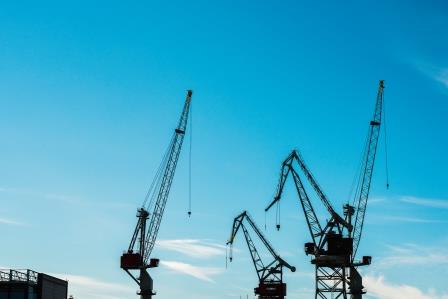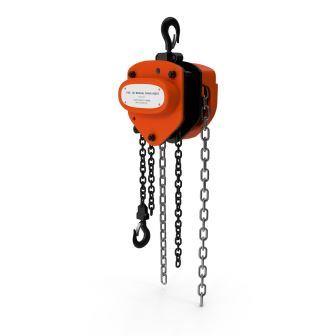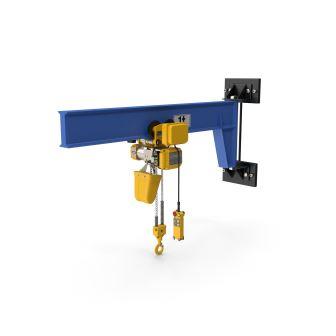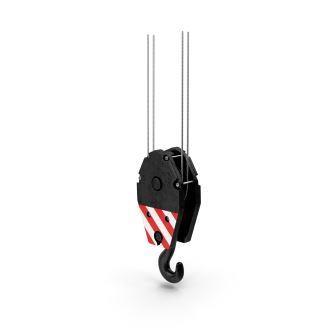A crane is a kind of machinery used to lift and transport all kinds of goods. As it is designed to withstand large amounts of weights, it is typically operated to move large, heavy and bulky items.

Hence, each crane part plays an equally important role in enabling the machine to function properly as a whole. The crane parts that will be focused on in this article consist of the hoist, trolley and hook.
1. Hoist
This element of the crane is responsible for both lifting and lowering of goods in a vertical motion. It is found to be on the bridge girder. The various kinds of hoists are:
- Electric chain hoist
- Wire rope hoist
- Chain hoist
The difference between the hoists is their ability to withstand the weight of the goods. With the ability to carry weights of more than 10 tons, the electric chain hoist is used for goods of larger weights. Wire rope hoist is usually used on goods weighing 5 tons and above while chain hoist is used for lighter weighing goods of 5 tons and below.

Hence, knowing the kinds of goods and its weights prior to the process of transporting them can be helpful in determining the type of hoist to use. The selection of the most appropriate hoist for the context can expedite the goods transportation process, making it more efficient. Additionally, using a suitable hoist can possibly prolong the lifespan of it since it would less likely be prone to working beyond its capability. Hence, reducing the chances of having to spend too much money on constantly having to repair and replace the hoist.
2. Trolley
The trolley is a wheeled device (important crane part component!) where the hoist is hung onto it. The main purpose of this component is to enable movement of both the hoist and hook along the path of the bridge element, usually in a horizontal direction. It is usually used to set the position of both the hoist and hook directly above the goods. This enables the crane to function more efficiently such that the hook is able to pick up the goods and transport it accurately.

There are three variations of trolley which are plain, geared and motorised. The plain trolley, also identified as a manual trolley, has the most basic design among the other versions. Hence, it requires the involvement of a human operator to perform the various actions. The actions often include positioning the trolley, retrieving the goods manually and placing them along the bridge. The usage of a geared trolley is more complex. It usually involves actions from the hoist operator where the chain suspended from the trolley will be pulled. With the presence of gears on the chain, the trolley is able to roll across the bridge. The motorised trolley is designed in a way where a motor is fixed onto its wheels. Generally, the operator is able to take control and move the trolley through pressing on the buttons. However, as the motorised trolley moves in a fast motion, it is extremely important to conduct various checks and training so that workers will know what to do during the usage process.
Apart from the different types of trolley, there are two different trolley placements present in cranes which are classified into top-running and bottom-running. Top-running trolley is mostly found in the double girder crane design while the bottom-running trolley is found in the single girder crane design.
3. Hook
This part of the crane is designed to carry goods, hence, it is essentially one of the most important parts of the crane.

With the need to lift the various kinds of objects, the hook comes in an assortment of styles. Generally, the hooks of a crane used differs depending on the purpose of activity as shown below:
| Types of hook | Description |
| Forging Crane Hooks | It is used to lift goods, typically in the manufacturing and production sector, with minimal stress and resistance applied on them. |
| Laminated Crane Hooks | It is mostly used to lift goods with large weights typically in the construction sector. |
| Single Crane Hooks | It is used to lift light weighing goods and is only able to withstand goods weighing not more than 75 tons. |
| Double Crane Hooks | It is used to lift heavier goods since it can handle goods weighing above 75 tons. |
As the hook always comes into contact with the objects, it wears out more quickly as compared to other parts of the crane. This results in the need for constant repair and maintenance of the hook.
Types of Cranes
Though there are a wide range of crane applications, it is more commonly used in the construction and manufacturing industries. To accommodate the various industries, cranes come in a variety of types and sizes. Cranes, in general, are split into 2 different types which are mainly mobile and fixed.
Mobile cranes are cranes that can move about the different areas in a site. They usually have wheels or tracks to enable the movement from one location to another. One of the more popular mobile cranes is known as the carry deck crane. The carry deck crane is often used in the construction industry to load and transport materials. Due to its small structure, it is easily navigated across points in a site, making it a very portable type of crane. Other examples of mobile cranes include floating cranes, truck-mounted cranes, crawler cranes and rough terrain cranes.
On the other hand, fixed cranes, also known as static cranes, are usually situated at one particular location of a site. Compared to mobile cranes, they are not able to move about freely but are able to carry heavier loads. For instance, a tower crane is commonly seen in construction sites to enable the building of high-rise buildings. This is mainly due to its tall structure and ability to withstand large amounts of weight. Other common instances of static cranes are bulk-handling cranes, stacker cranes, overhead cranes, telescopic cranes and hammerhead canes.
Conclusion
With cranes being constructed with varying designs and materials, finding the right type of crane and its appropriate crane parts to use can be an especially tedious process. Hence, it is always advisable to engage with crane parts specialists to consult with them on your crane designs. It is also important to find a reliable crane parts supplier that can constantly provide you with high quality supply for each required crane part when needed.
 Tasselline | Latest Articles By Singaporeans, for Singaporeans Article Site for Singaporeans
Tasselline | Latest Articles By Singaporeans, for Singaporeans Article Site for Singaporeans